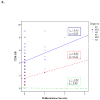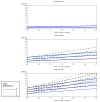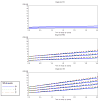Neuropsychiatric symptoms and global functional impairment along the Alzheimer's continuum
- PMID: 22922821
- PMCID: PMC3549662
- DOI: 10.1159/000342119
Neuropsychiatric symptoms and global functional impairment along the Alzheimer's continuum
Abstract
Background/aims: Neuropsychiatric symptoms in Alzheimer's disease (AD) are highly prevalent. We sought to determine whether neuropsychiatric symptoms were related to global functional impairment at baseline and over a 3-year period in older normal control (NC), mild cognitive impairment (MCI) and mild AD dementia subjects.
Methods: Eight hundred and twelve subjects (229 NC, 395 MCI, 188 AD) from the Alzheimer's Disease Neuroimaging Initiative study underwent cognitive and behavioral assessments over 3 years.
Results: Greater hallucinations, anxiety and apathy were associated with greater global functional impairment at baseline, while the presence of hallucinations and apathy at baseline was associated with greater global functional impairment over time across all subjects. The following neuropsychiatric symptoms were not significantly associated with global functioning: delusions, agitation, depression, euphoria, disinhibition, irritability, aberrant motor behaviors, sleep and appetite.
Conclusions: These results suggest that increased baseline hallucinations, apathy and anxiety are associated with current and future disease progression in AD.
Copyright © 2012 S. Karger AG, Basel.
Figures









References
-
- Lyketsos CG, Lopez O, Jones B, Fitzpatrick AL, Breitner J, DeKosky S. Prevalence of neuropsychiatric symptoms in dementia and mild cognitive impairment: results from the cardiovascular health study. JAMA. 2002;288:1475–1483. - PubMed
-
- Apostolova LG, Cummings JL. Neuropsychiatric manifestations in mild cognitive impairment: a systematic review of the literature. Dement Geriatr Cogn Disord. 2008;25:115–126. - PubMed
-
- Tschanz JT, Corcoran CD, Schwartz S, Treiber K, Green RC, Norton MC, Mielke MM, Piercy K, Steinberg M, Rabins PV, Leoutsakos JM, Welsh-Bohmer KA, Breitner JC, Lyketsos CG. Progression of cognitive, functional, and neuropsychiatric symptom domains in a population cohort with Alzheimer dementia: the cache county dementia progression study. Am J Geriatr Psychiatry. 2011;19:532–542. - PMC - PubMed
Publication types
MeSH terms
Grants and funding
LinkOut - more resources
Full Text Sources
Medical

